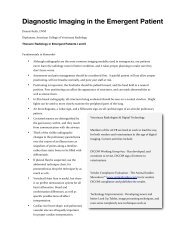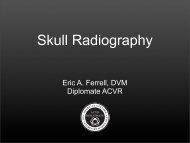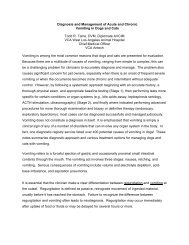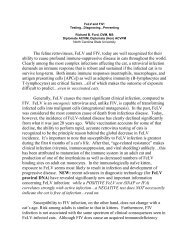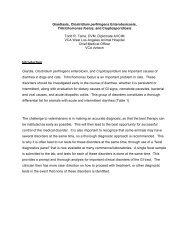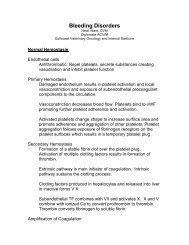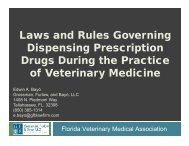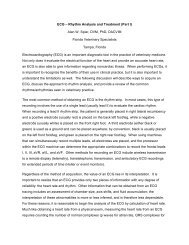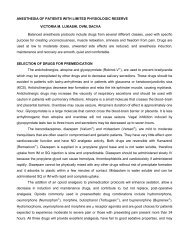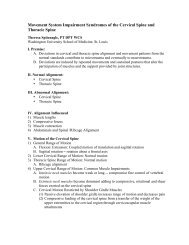Adrenal AxisTesting: Making the Diagnosis Cynthia R. Ward, VMD ...
Adrenal AxisTesting: Making the Diagnosis Cynthia R. Ward, VMD ...
Adrenal AxisTesting: Making the Diagnosis Cynthia R. Ward, VMD ...
You also want an ePaper? Increase the reach of your titles
YUMPU automatically turns print PDFs into web optimized ePapers that Google loves.
<strong>Adrenal</strong> <strong>AxisTesting</strong>: <strong>Making</strong> <strong>the</strong> <strong>Diagnosis</strong><br />
<strong>Cynthia</strong> R. <strong>Ward</strong>, <strong>VMD</strong>, PhD, Dipl. ACVIM<br />
Professor of Medicine<br />
Chief of Staff Inpatient Medicine<br />
University of Georgia School of Veterinary Medicine<br />
April, 2011<br />
I. Regulation of Secretion of glucocorticoids - corticosterone and cortisol<br />
A. hypothalamic-pituitary-adrenal (HPA) axis - classic endocrine<br />
feedback loop<br />
a. CRH (hypothalamus)<br />
b. ACTH (pituitary)<br />
c. Cortisol (adrenals)<br />
d. Cortisol negative feedback on CRH and ACTH release<br />
II. Diseases of <strong>the</strong> <strong>Adrenal</strong> Cortex and how to diagnose <strong>the</strong>m<br />
A. Hypoadrenocorticism<br />
a. primary disease - destruction of <strong>the</strong> adrenal cortex<br />
b. iatrogenic<br />
i. mitotane (Lysodren)<br />
ii. trilostane (Vetoryl) – can also cause adrenal necrosis<br />
iii. abrupt withdrawal of glucocorticoids<br />
iv. bilateral adrenalectomy<br />
B. <strong>Diagnosis</strong><br />
a. Decreased Na:K ratio - less than 25-27 consistent with addison’s disease<br />
b. ACTH-stimulation test – definitive test<br />
i. normal pre 1-4 mcg/dl cortisol<br />
ii. normal post 10-18 mcg/dl cortisol<br />
iii. Addisons: pre and post sample
Dr. <strong>Ward</strong>, University of Georgia Page 2<br />
1. rationale: gives cortisol estimation since last time dog urinated - so<br />
usually get an estimate of plasma cortisol over several hours<br />
2. procedure: collect urine sample (preferably owners collect at home);<br />
urine cortisol measured and compared to creatinine to normalize<br />
for urine concentration<br />
3. interpretation - if morning urine (really should be 3 on separate days)<br />
sample(s) less than 10 (or use your lab’s reference ranges) <strong>the</strong>n<br />
animal probably doesn’t have Cushing’s. If > 10 <strong>the</strong>n you need to<br />
do ano<strong>the</strong>r screening test. Very sensitive; not specific<br />
b. ACTH-stimulation test<br />
1. rationale: stimulate gland to determine hormonal reserve;<br />
if gland is hyperfunctioning you should get an exaggerated<br />
response<br />
2. interpretation:<br />
(1) normal pre 1-4 mcg/dl cortisol<br />
normal post 10-18 mcg/dl cortisol<br />
(2) gray area post sample (may/may not be<br />
hyperadrenocorticism)18-22 mcg/dl<br />
(3) post > 22 mcg/dl think hyperadrenocorticism<br />
3. uses:<br />
(1) test of choice for diagnosing iatrogenic<br />
hyperadrenocorticism<br />
(2) screening test for hyperadrenocorticism – is a more<br />
specific test in animals with concurrent disease<br />
(3) monitoring lysodren <strong>the</strong>rapy<br />
(4) 60-75% sensitive<br />
(5) 85-90% specific<br />
c. Low Dose Dexamethasone Suppression Test (LDDS)<br />
1. rationale: take advantage of <strong>the</strong> normal negative feedback<br />
mechanism in <strong>the</strong> HPA axis. If you can’t suppress<br />
<strong>the</strong> system normally, <strong>the</strong>n suspect hyperadrenocorticism<br />
2. procedure:<br />
(1) get baseline cortisol<br />
(2) give 0.01 mg/kg dexamethasone IV<br />
(3) get 4 and 8 hour post-injection cortisol samples<br />
(4) can use dexamethasone SP or dexamethasone in<br />
polyethylene glycol<br />
3. interpretation:<br />
(1) look at <strong>the</strong> 8 hour post-injection sample first; in a<br />
normal animal it should be below <strong>the</strong> normal range; <strong>the</strong><br />
gray area in which you can’t make a diagnosis is 1.0-1.4<br />
ug/dl; greater than 1.4 mcg/dl is consistent with<br />
hyperadrenocorticism<br />
(2) <strong>the</strong> 4 hr post-injection sample is used as a<br />
discriminating test (to tell whe<strong>the</strong>r <strong>the</strong>re is an adrenal tumor or<br />
PDH)<br />
4. advantages:<br />
(1) more sensitive for diagnosis of hyperadrenocorticism<br />
85-95% sensitive
Dr. <strong>Ward</strong>, University of Georgia Page 3<br />
(2) by getting <strong>the</strong> four hour sample, can also use as a<br />
discriminating test for hyperadrenocorticism (i.e.<br />
tell whe<strong>the</strong>r hyperadrenocorticism is due to a<br />
pituitary or adrenal tumor)<br />
5. disadvantages:<br />
(1) 8 hour test<br />
(2) may be less specific in animals with concurrent disease<br />
(i.e. get false positives) 70-75% specific<br />
6. uses:<br />
(1) screening test for hyperadrenocorticism<br />
(2) discriminating test for hyperadrencorticism<br />
3. Discriminating Tests for <strong>Adrenal</strong> Function<br />
(tests to differentiate pituitary- versus adrenal-dependent hyperadrenocorticism)<br />
a. Low Dose Dexamethasone Suppression test – 4 hour sample<br />
b.. Endogenous ACTH levels<br />
i. measure on a single blood sample<br />
ii. if how – adrenal tumor<br />
iii. if very high – PDH<br />
iv. significant overlap between normal and dogs with PDH<br />
c. Ultrasound<br />
i. look for adrenal tumors and contralateral adrenal atrophy<br />
ii. look for bilateral adrenal enlargement<br />
iii.look for potential metastatic disease<br />
d. High Dose Dexamethasone Test (HDDST)-no longer recommended<br />
ACTH-Stimulation Test<br />
1. Syn<strong>the</strong>tic ACTH (cortrosyn)<br />
2. ACTH gel – compounded by compounding pharmacy (be careful)<br />
3. Cortrosyn<br />
a. 5 mcg/kg cortrosyn IV (or IM)<br />
b. adrenal hormone(s) that you want to measure before and 45-60 min after<br />
injection<br />
c. Can reconstitute and freeze cortorsyn in aliquots. Stable for 6 months.<br />
4. ACTH gel – trust your pharmacy<br />
a. 2.2 U/kg IM or check with your pharmacy<br />
b. <strong>Adrenal</strong> hormone(s) measured pre and 2 hours post injection<br />
C. Feline <strong>Adrenal</strong> Axis Testing<br />
a. LDDST – use 0.1 mg/kg of dexamethasone (instead of 0.01 mg/kg of<br />
dex for a dog); use <strong>the</strong> same criteria for diagnosing<br />
hyperadrenocorticism<br />
b. ACTH-stimulation test<br />
i. 5 ug/kg syn<strong>the</strong>tic ACTH IV<br />
ii. Cortisol levels at 60 and 90 minutes<br />
iii. Cortisol above 16 ug/dl (slightly lower than dogs) consistent<br />
with hyperadrenocorticism<br />
iv. Low sensitivity (~50%)<br />
c. <strong>Adrenal</strong> ultrasonography



